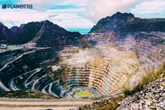Understanding the next steps in the $20 trillion seabed mining opportunity
Published by Jess Watts,
Editorial Assistant
Global Mining Review,

Interest in mining the seabed has dramatically accelerated thanks to recent US moves to allow mining inside and outside its own territorial waters. While this is clearly controversial given that regulations to cover extraction within international waters are still being developed by the International Seabed Authority (ISA)- created by the United Nations Convention on the Law of the Sea, which the US has not ratified, it demonstrates the potential and risks in this area.
The positive benefits of seabed mining
Seabed mining offers a US$20 trillion opportunity to extract critical minerals that are essential for batteries, electric vehicles (EVs), and other green technologies. While traditional land-based mining is increasingly constrained by diminishing ore grades, stricter environmental regulations, and rising production costs, seabed deposits are staggeringly abundant and generally higher quality. For example, analysis based on US Geological Survey data demonstrates that seabed manganese reserves are over four times greater than those on land.
Recent innovations are making seabed mining increasingly feasible. Echo-sounding bathymetry, for example, uses sonar to enable detailed mapping and sampling of the seabed, providing high-resolution images for identifying resource-rich areas. Advances in underwater vehicles are also helping to make mining more viable, although challenging, complex operating conditions still mean that projects are costly.
Understanding the scenarios for the future
As well as a lack of developed regulations, seabed mining also brings significant environmental considerations. In 2023 5000 new species were discovered in the Clarion-Clipperton Zone (CCZ) between Hawaii and Mexico, an area that contains an estimated 30 billion metric t of polymetallic manganese nodules. Companies including Volvo, Volkswagen, BMW, Google, Patagonia, Philips, Samsung SDI, and Scania have all said that say they will not use deep-sea mined metals until the environmental risks are “comprehensively understood.”
With the US pushing forward on fast-tracking permits for deep sea mining, there are three viable scenarios for the industry. The most likely is that competing regulatory frameworks emerge, eroding the ISA’s authority and leading to a lack of unified environmental or operational standards, risking environmental degradation. Alternatively, concerted national and environmental pressure and legal action could lead to the ISA mining code being finalised and enforced globally, or finally a free-for-all competitive resource rush may develop, with countries adopting their own standards. Currently, the first scenario is most likely given the momentum behind US initiatives and the lack of progress with the ISA’s regulations.
Options for the industry
The Metals Company (TMC) has already submitted an application to the US government for a permit to begin operations. Given the scale, risk, and cost of the opportunity, other mining players need to understand their own options. They should closely monitor the regulatory situation, and build resilient supply chains and partnerships with a range of countries. To secure permits, maintain a social license to operate, and mitigate reputational risks they need to demonstrate strict environmental stewardship, all while developing contingency plans for different regulatory and market scenarios. This will enable them to properly evaluate opportunities and potentially dive into the opportunity moving forward.
Read the article online at: https://www.globalminingreview.com/mining/16052025/understanding-the-next-steps-in-the-20-trillion-seabed-mining-opportunity/
You might also like
The dual threat facing modern mining
Extreme weather is reshaping mining – driving floods, drought, and costly disruptions. Long-range environmental forecasting offers a path to safer operations, stronger infrastructure, and planning amid a rapidly intensifying water cycle.


